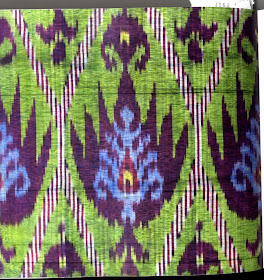Ikats are woven textiles that are created all over the world
most notably in Japan, China and Central Asia. The warped patterns on them are
created by tie-dyeing the unwoven threads in patterns. When the threads are
woven together, the pattern is formed by the changing colour of the dyed
threads, but creates a ‘shifted’ version of the design. Though actually a
process of surface design created by the construction of the fabric, ikats have
been one of the main influences on my work.
The ikats worn as part of traditional dress in such
countries as Uzbekistan, Turkmenistan and Kazakhstan were a way of creating
elaborate personal costumes, and were also often used as wall hangings for home
decoration. In Central Asian cultures,
the use of fabric and garments is very important. Ikat robes were often given
to important visitors as gifts. Made
from silk and when woven painted with an egg-white solution to stiffen the
fabric and make it glossy, the ikats could be incredibly expensive, and so were
reserved for those of high social status or special occasions. Often officials or members of royalty would
wear up to ten robes at once in order to show off their wealth and status. Cheaper versions of the silk ikats were also
woven using silk and cotton threads or just cotton threads.
I first discovered ikats whilst looking at bold and brightly
coloured floral fabrics designed by Russian factories for import to the Central
Asian markets. These Russian fabrics
were very cheap and used by the peoples of Central Asia to make every-day robes,
or line the insides of traditional robes made out of the local ikat
fabric. It was the clash of these two
very different fabrics used to make the robes that appealed to me the most, and
made me consider the clash of surface within collage. The warped ikats
suggested the feel of striped cloth to me, whilst the shifted patterns of the
original design suggested a narrative to the fabrics, like a faded design worn
away over time. I began trying to
re-create this feeling within my own pattern design, both visually with stripes
of different tones of a certain colour, and with the re-use of found imagery,
through the use of collage.
















